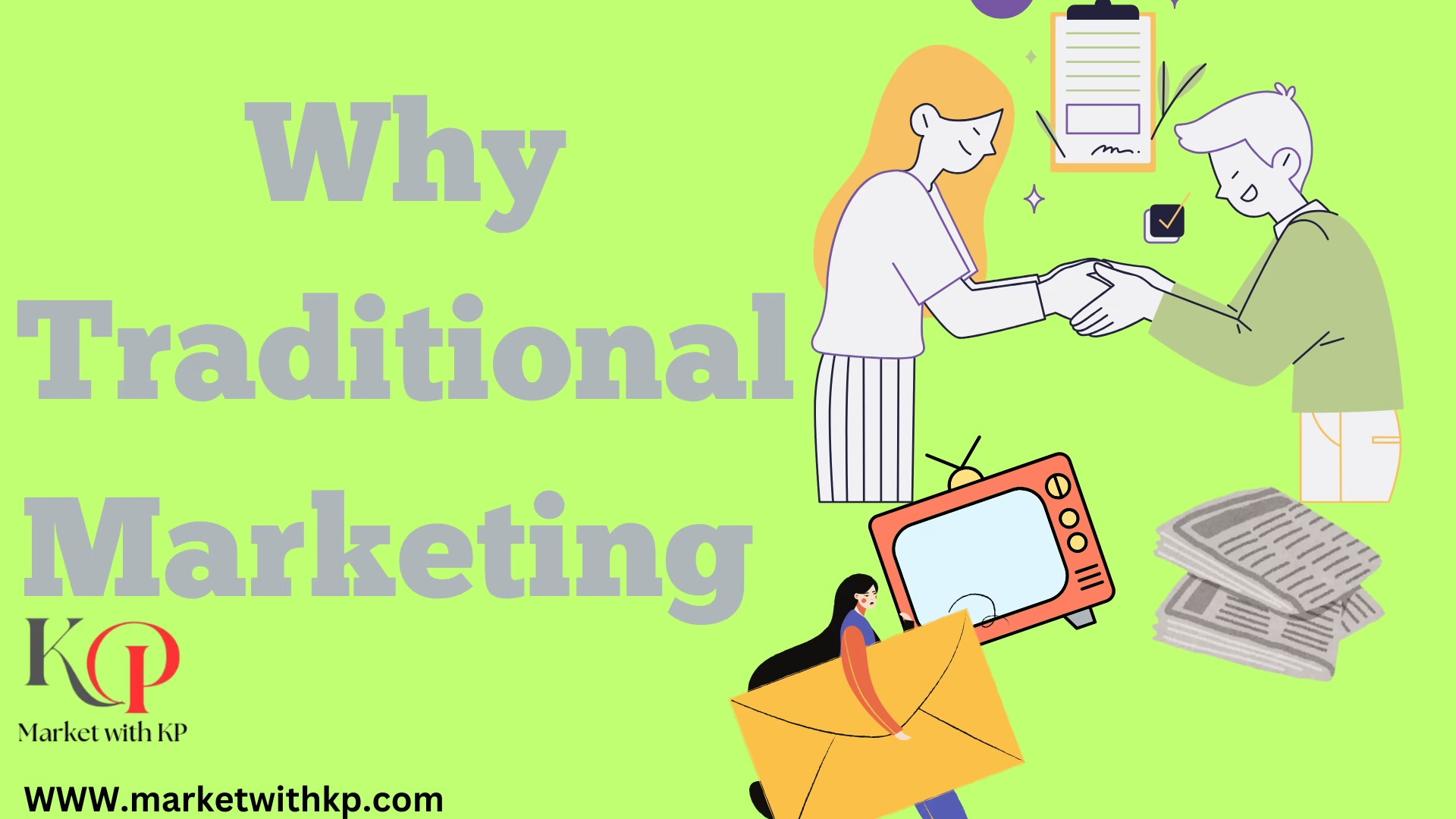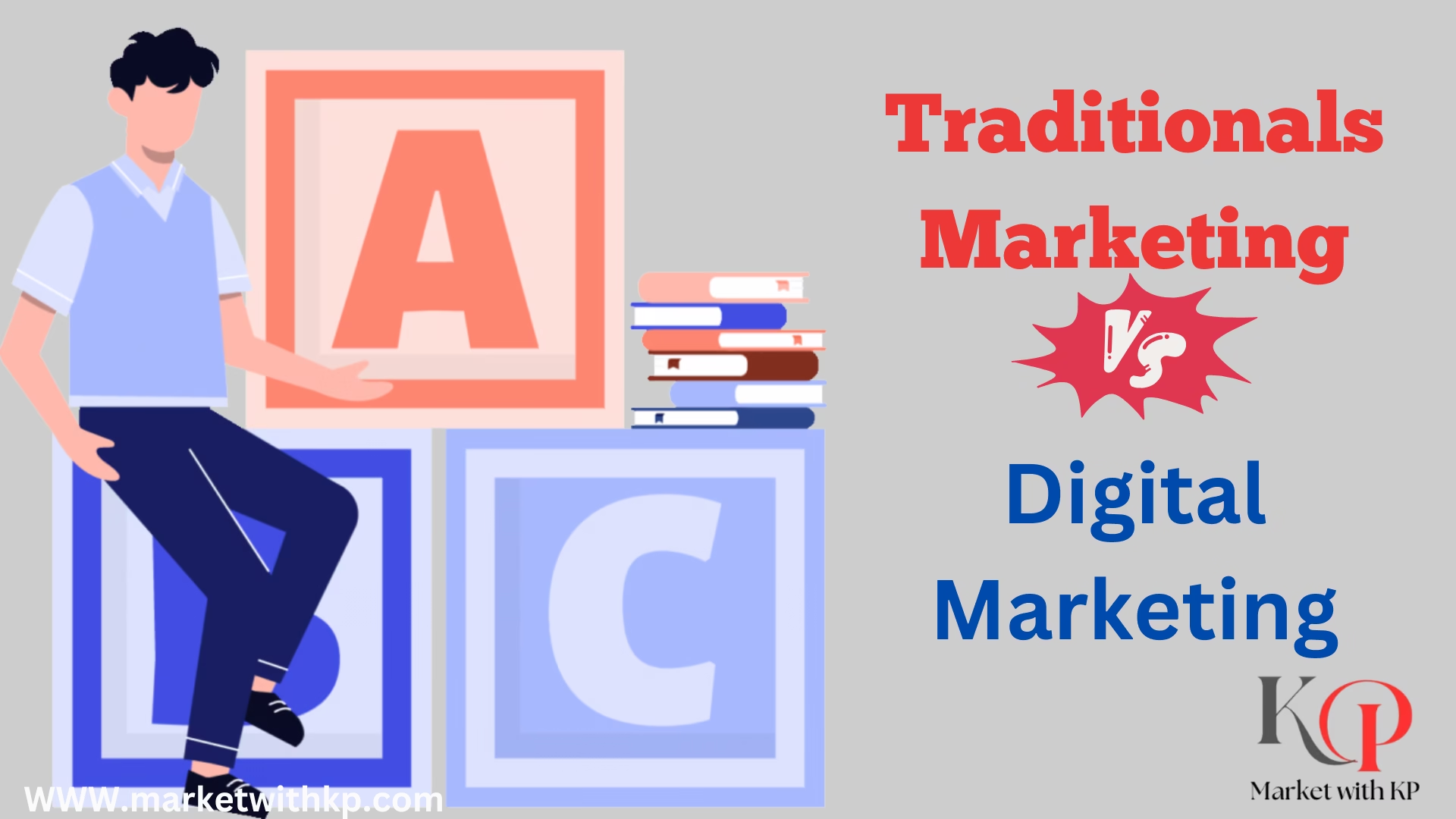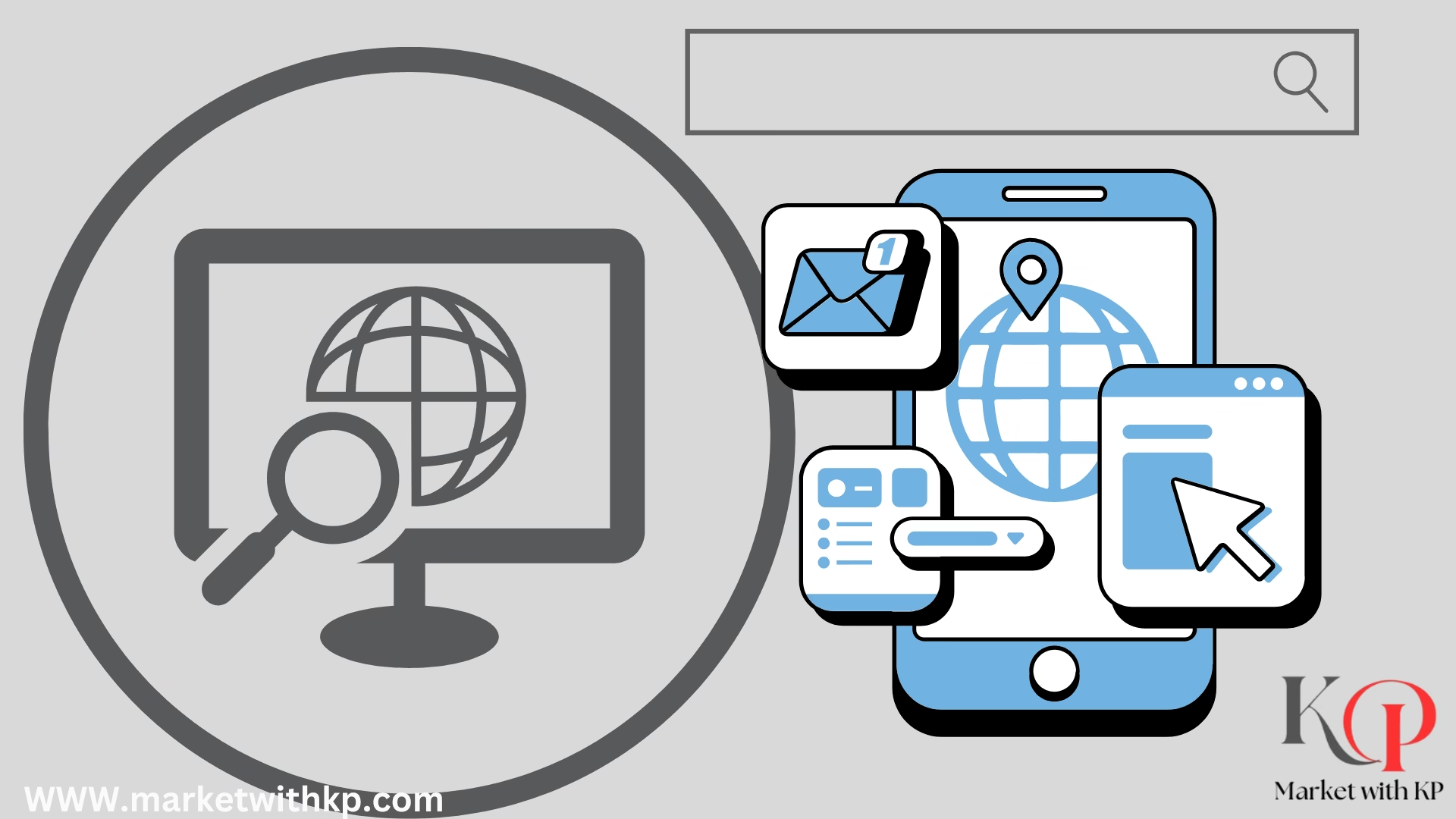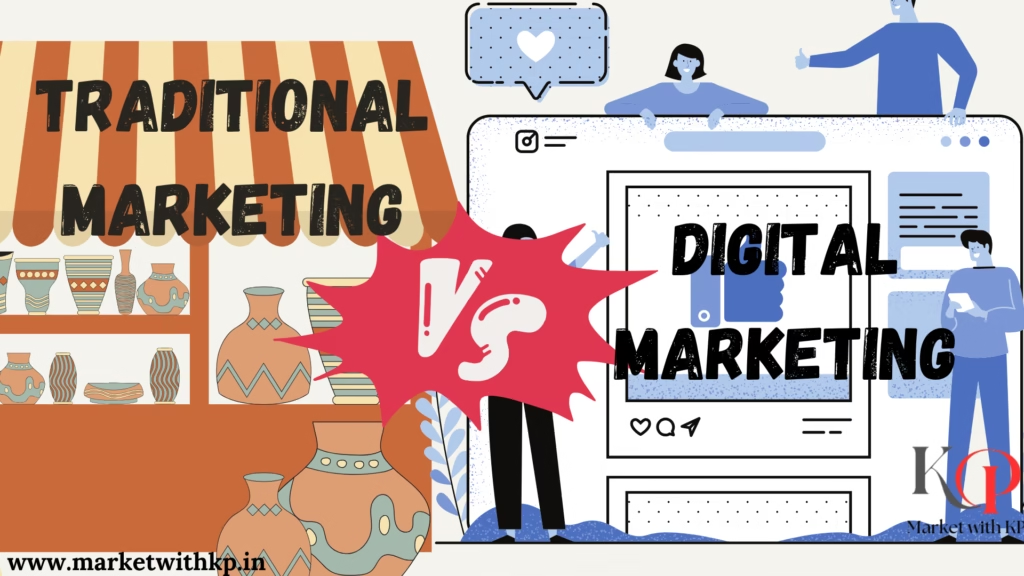Marketing is the lifeblood of any business. For small businesses, in particular, it’s the bridge between a great product or service and the customers who need it. As the marketing landscape evolves, businesses face a pivotal choice: stick with time-tested traditional marketing or embrace the dynamic world of digital marketing. Understanding the strengths, limitations, and potential of each approach is essential for making an informed decision.
Traditional Marketing: The Foundation of Brand Building

Traditional marketing encompasses methods that have stood the test of time. These include print advertisements, radio and TV commercials, billboards, direct mail, and events or sponsorships. For decades, these methods were the primary ways businesses reached their target audiences.
Strengths of Traditional Marketing

- Tangibility and Credibility: Print materials like brochures, business cards, and magazines are tangible items that people can hold. This physical presence often lends credibility to a brand.
- Wider Local Reach: Methods such as local newspaper ads and community sponsorships are excellent for connecting with a local audience, which is crucial for many small businesses.
- Memorable Branding: Television and radio ads often have a lasting impact because of their audio-visual and emotional appeal. A catchy jingle or slogan can become ingrained in a customer’s memory.
- Broad Audience Appeal: Older generations or individuals less tech-savvy may respond better to traditional media, making it a necessary channel for certain demographics.
Limitations of Traditional Marketing
- High Costs: Producing and airing a TV commercial or buying ad space in a major publication can be prohibitively expensive for small businesses.
- Limited Measurability: It’s challenging to track the effectiveness of a traditional marketing campaign. Metrics like reach and conversion often rely on estimates rather than precise data.
- Lack of Flexibility: Once a campaign is launched, it’s difficult to make changes without incurring significant costs.
Digital Marketing: The New Frontier

Digital marketing leverages the internet and electronic devices to promote products or services. Channels include social media, search engines, email marketing, content marketing, and paid online ads. This approach has revolutionized the way businesses engage with customers.
Strengths of Digital Marketing
- Cost-effectiveness: Platforms like social media allow businesses to run ads tailored to their budgets, often at a fraction of the cost of traditional methods.
- Precise Targeting: Tools like Google Ads and Facebook Ads Manager enable businesses to target specific demographics, interests, and behaviors, ensuring that marketing efforts reach the right audience.
- Real-Time Analytics: Digital campaigns provide instant feedback. Metrics such as click-through rates, conversion rates, and engagement levels help businesses refine their strategies in real-time.
- Global Reach: A small business in a local community can gain customers from around the world through a robust digital presence.
- Interactive Engagement: Features like comments, shares, and likes foster direct communication between businesses and their customers, building stronger relationships.
Limitations of Digital Marketing
- Overcrowded Marketplace: With so many businesses competing for attention online, it can be challenging to stand out.
- Technical Skills Required: Effective digital marketing often requires expertise in SEO, graphic design, data analysis, and content creation.
- Reliance on Technology: Dependence on digital platforms means that technical glitches or algorithm changes can disrupt marketing efforts.
Comparing Traditional and Digital Marketing

Budget Considerations
For small businesses with limited budgets, digital marketing is often more accessible. However, strategic investments in traditional marketing—such as sponsoring a local event or running a well-placed newspaper ad—can yield significant returns in specific contexts.
Audience Demographics
Understanding the target audience is key. For instance, a business targeting senior citizens might find traditional marketing more effective, while a brand aimed at millennials or Gen Z would benefit from a strong digital presence.
Measurability and Adaptability
Digital marketing’s ability to provide real-time data and make on-the-fly adjustments gives it a clear advantage. Traditional marketing, while impactful, lacks this flexibility.
Longevity and Impact
A well-designed billboard or TV commercial can create a long-lasting impression. Digital ads, while cost-effective and targeted, often have a shorter lifespan unless they go viral.
The Case for Integrating Both Approaches
For small businesses, the choice between traditional and digital marketing doesn’t have to be an either-or decision. Integrating both approaches can create a balanced strategy that leverages the strengths of each.
Example Strategies:
- Event Sponsorship with Digital Amplification: Sponsor a local event and use social media to share photos, videos, and customer testimonials from the event.
- Print Ads with Digital Call-to-Actions: Include a QR code or website link in print materials to drive traffic to your online platforms.
- Content Marketing Paired with Direct Mail: Send a branded magazine or brochure to customers’ homes, directing them to your blog or online store for more information.
Practical Tips for Small Businesses

Running a small business can be both rewarding and challenging. With limited resources and growing competition, it’s crucial to adopt strategies that foster growth and efficiency. Whether you’re just starting out or looking to improve an existing business, these practical tips can set you on the path to sustained success.
Understand Your Market
Knowing your target audience is the cornerstone of any successful business. Conduct market research to identify your customers’ needs, preferences, and pain points. Use surveys, focus groups, and online tools like Google Analytics to gather data. A clear understanding of your market helps tailor your products or services to meet demand effectively.
Create a Solid Business Plan
A well-structured business plan serves as a roadmap for your business. It should include:
- Your mission and vision
- Market analysis
- Financial projections
- Marketing and sales strategies
Regularly revisit and update your plan to adapt to changing market conditions.
Embrace Technology
Technology can streamline operations and boost productivity. Here are some tools to consider:
- Accounting Software: QuickBooks or Xero for financial management.
- Customer Relationship Management (CRM): HubSpot or Salesforce to manage customer interactions.
- Project Management Tools: Trello or Asana for team collaboration.
Investing in technology can save time, reduce errors, and enhance customer service.
Focus on Customer Experience
Customer satisfaction is key to retention and word-of-mouth referrals. Ensure your team is trained to deliver exceptional service. Simple gestures like personalized communication, quick responses to inquiries, and resolving issues promptly can make a big difference. Additionally, ask for customer feedback and act on it to continually improve your offerings.
Build a Strong Online Presence

In today’s digital age, an online presence is non-negotiable. Start by creating a professional website with essential information like your services, contact details, and testimonials. Optimize your site for mobile users and incorporate search engine optimization (SEO) practices to improve visibility.
Social media platforms like Instagram, Facebook, and LinkedIn are excellent for engaging with your audience. Post regularly, share valuable content, and use paid advertising to expand your reach.
Master Financial Management
Keeping a close eye on your finances ensures long-term stability. Here are some tips:
- Separate personal and business finances.
- Monitor cash flow regularly.
- Set aside a portion of your revenue for emergencies.
- Consult with a financial advisor or accountant for expert advice.
Controlling expenses and maximizing profits are essential for growth.
Network and Build Relationships
Networking opens doors to opportunities like partnerships, collaborations, and new customers. Attend industry events, join local business associations, and participate in online forums relevant to your niche. Building strong relationships with suppliers, customers, and peers can lead to valuable referrals and insights.
Prioritize Employee Well-Being
Your team is the backbone of your business. Foster a positive work environment by:
- Offering fair compensation and benefits.
- Providing growth opportunities through training and development.
- Encourage open communication and feedback.
Happy employees are more productive and contribute to a positive company culture.
Set Realistic Goals

Goal setting provides direction and motivation. Use the SMART criteria:
- Specific: Clearly define what you want to achieve.
- Measurable: Establish metrics to track progress.
- Achievable: Ensure the goal is realistic given your resources.
- Relevant: Align the goal with your business objectives.
- Time-bound: Set a deadline for completion.
Regularly review and adjust your goals to reflect changing circumstances.
Leverage Marketing Strategies
Effective marketing drives awareness and sales. Consider these strategies:
- Content Marketing: Share blogs, videos, and infographics that educate and engage your audience.
- Email Marketing: Send newsletters and promotional offers to your subscribers.
- Local Marketing: Use geo-targeted ads and participate in community events.
- Influencer Partnerships: Collaborate with influencers in your industry to reach a wider audience.
Track the performance of your campaigns to refine your approach.
Stay Adaptable
The business landscape is constantly evolving. Being adaptable allows you to pivot when needed. Stay informed about industry trends and be open to change. Whether it’s adopting new technologies or adjusting your business model, flexibility is crucial for long-term success.
Invest in Branding

A strong brand differentiates you from competitors and builds customer loyalty. Your branding should reflect your values, mission, and unique selling proposition. Consistency in your logo, color scheme, tone of voice, and messaging creates a memorable impression.
Monitor Competitors
Keeping an eye on your competitors helps you stay ahead. Analyze their strengths and weaknesses, pricing strategies, and marketing tactics. Identify gaps in the market that you can fill. However, focus on innovation rather than imitation to maintain your unique identity.
Seek Professional Advice
Don’t hesitate to consult experts when needed. Legal advisors, accountants, and business consultants can provide valuable guidance. Their insights can help you avoid costly mistakes and make informed decisions.
Celebrate Milestones

Recognizing achievements, big or small, boosts morale and motivation. Celebrate business anniversaries, hitting sales targets, or completing major projects. Share these milestones with your team and customers to foster a sense of community and accomplishment.
Implement Sustainable Practices
Sustainability is becoming increasingly important to consumers. Incorporate eco-friendly practices like reducing waste, sourcing responsibly, and minimizing energy consumption. Highlight these efforts in your marketing to appeal to environmentally conscious customers.
Utilize Data Analytics
Data-driven decisions are more effective. Use analytics tools to track customer behavior, sales trends, and marketing performance. Insights from data can help you identify opportunities for improvement and growth.
Be Patient and Persistent
Success doesn’t happen overnight. Building a thriving small business requires time, effort, and resilience. Stay committed to your vision and don’t be discouraged by setbacks. Learn from challenges and use them as stepping stones to progress.
Conclusion
Both traditional and digital marketing have their unique strengths and challenges. For small businesses, the best approach often depends on the target audience, budget, and specific goals. By carefully evaluating these factors and considering an integrated strategy, small businesses can harness the power of both worlds, ensuring a well-rounded and effective marketing presence.
In today’s competitive landscape, adaptability is key. Embracing both traditional and digital methods while staying attuned to evolving consumer behavior can position small businesses for sustained growth and success.
Author: Ilyas


Great comparison! This article clearly outlines the benefits of digital marketing over traditional methods for small business growth and visibility.